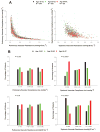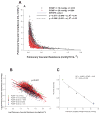Pulmonary capillary wedge pressure augments right ventricular pulsatile loading
- PMID: 22131357
- PMCID: PMC3264431
- DOI: 10.1161/CIRCULATIONAHA.111.051540
Pulmonary capillary wedge pressure augments right ventricular pulsatile loading
Abstract
Background: Right ventricular failure from increased pulmonary vascular loading is a major cause of morbidity and mortality, yet its modulation by disease remains poorly understood. We tested the hypotheses that, unlike the systemic circulation, pulmonary vascular resistance (R(PA)) and compliance (C(PA)) are consistently and inversely related regardless of age, pulmonary hypertension, or interstitial fibrosis and that this relation may be changed by elevated pulmonary capillary wedge pressure, augmenting right ventricular pulsatile load.
Methods and results: Several large clinical databases with right heart/pulmonary catheterization data were analyzed to determine the R(PA)-C(PA) relationship with pulmonary hypertension, pulmonary fibrosis, patient age, and varying pulmonary capillary wedge pressure. Patients with suspected or documented pulmonary hypertension (n=1009) and normal pulmonary capillary wedge pressure displayed a consistent R(PA)-C(PA) hyperbolic (inverse) dependence, C(PA)=0.564/(0.047+R(PA)), with a near-constant resistance-compliance product (0.48±0.17 seconds). In the same patients, the systemic resistance-compliance product was highly variable. Severe pulmonary fibrosis (n=89) did not change the R(PA)-C(PA) relation. Increasing patient age led to a very small but statistically significant change in the relation. However, elevation of the pulmonary capillary wedge pressure (n=8142) had a larger impact, significantly lowering C(PA) for any R(PA) and negatively correlating with the resistance-compliance product (P<0.0001).
Conclusions: Pulmonary hypertension and pulmonary fibrosis do not significantly change the hyperbolic dependence between R(PA) and C(PA), and patient age has only minimal effects. This fixed relationship helps explain the difficulty of reducing total right ventricular afterload by therapies that have a modest impact on mean R(PA). Higher pulmonary capillary wedge pressure appears to enhance net right ventricular afterload by elevating pulsatile, relative to resistive, load and may contribute to right ventricular dysfunction.
© 2011 American Heart Association, Inc.
Conflict of interest statement
Figures





References
-
- Stergiopulos N, Segers P, Westerhof N. Use of pulse pressure method for estimating total arterial compliance in vivo. American Journal of Physiology - Heart and Circulatory Physiology. 1999;276:H424–H428. - PubMed
-
- Sipkema P, Latham R, Westerhof N, Rubal B, Slife D. Isolated aorta setup for hemodynamic studies. Ann Biomed Eng. 1990;18:491–503. - PubMed
-
- Lankhaar J, Westerhof N, Faes TJC, Marques KMJ, Marcus JT, Postmus PE, Vonk-Noordegraaf A. Quantification of right ventricular afterload in patients with and without pulmonary hypertension. American Journal of Physiology - Heart and Circulatory Physiology. 2006;291:H1731–H1737. - PubMed
-
- Lankhaar J, Westerhof N, Faes TJC, Tji-Joong Gan C, Marques KM, Boonstra A, van den Berg FG, Postmus PE, Vonk-Noordegraaf A. Pulmonary vascular resistance and compliance stay inversely related during treatment of pulmonary hypertension. European Heart Journal. 2008;29:1688–1695. - PubMed
Publication types
MeSH terms
Grants and funding
LinkOut - more resources
Full Text Sources

